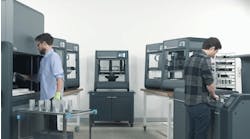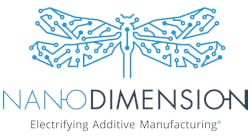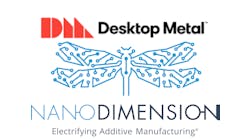By Chris McNamara, Smart Industry editor in chief
Technology tends to snowball…one development spurs another, which spurs another, etc. Consider the smart phone prompting the explosion of apps, which enable ride-sharing, which is fueling the development of autonomous vehicles.
That snowball metaphor is particularly appropriate to additive manufacturing, or 3D printing, which in many cases literally involves building layer upon layer.
Smart Industry's Chris McNamara
Mind you, this is still an emerging field. (Did you have to read that “3D printing” descriptor before you recognized what additive manufacturing is?) But the technology is already evolving, already morphing as it gains adoption across the industrial world.
It’s already snowballing. “We can expect to see continued rapid growth of additive manufacturing for production applications,” opines William King, co-founder and CEO of Fast Radius, a Chicago-based additive-manufacturing company.
“Companies are moving out of the exploratory phase and starting to adopt additive as a scalable manufacturing solution. This is because additive technologies and materials continue to get better, faster and cheaper.”
Coupling additive manufacturing with ERP
As additive-manufacturing adoption widens and an understanding of the applications and benefits deepens, the approach is increasingly being embedded into—and dictating—business strategy.
Bill Leedale, senior advisor with IFS, believes that folding additive manufacturing into enterprise resource planning (ERP) and even demand-driven materials resource planning (DDMRP) will help organizations disrupt the market by unlocking hidden business potential—from repeatable cost savings to comprehensive use of digital twins.
“Having ERP as an overarching system to aid additive-manufacturing operations is crucial,” he says, advising manufacturers to plan production around the low volume constraints of 3D-printing machinery and plan inventory of materials based on demand. “This requires the ERP software to recognize 3D printers as productive assets or workstations.”
Productive assets is right, increasingly as business owners recognize that traditional limits in product design are evaporating in this digital era. If it can be imagined, there’s a good chance it can be manufactured. “Design is less constrained by manufacturability,” says Leedale.
As such, businesses are less constrained. But, again, proper planning and processes that account for this new technology must be in place. As turn times are reduced, for example, the scheduling of part-delivery takes on added importance. This affects the full supply chain. “Without properly defined workflows in ERP, the organization itself will place constraints on what can be accomplished,” says the senior advisor.
Poor planning=sub-optimal performance. Proper planning=new revenue streams.
A spiral syringe needle (left) produced with the microArch 3D printing system right).
“With an optimum number of 3D printers, a strong business case and the right ERP software, manufacturers can unlock business value in design flexibility and lead times, all while reducing inventories,” summarizes Leedale. “Strong manufacturing ERP equipped for DDMRP will help them not only master workflows and turn times, but also win and retain business. As simple as it sounds, this can provide a manufacturer with a competitive advantage.”
Going small...really, really small
“When it comes to additive manufacturing the next major frontier of innovation isn’t big, it’s high-precision small parts.”
That’s John Kawola, CEO at Boston Micro Fabrication, which recently launched microArch, a high-resolution microscale 3D-printing solution for commercial use that, according to its maker, enables manufacturers to print ultra-high-resolution parts—down to the micron level—with accuracy and precision at scale.
Just how small? Boston Micro Fabrication boasts that its microArch can print down to a resolution of 2µ with a tolerance of ±10µm /±25µm.
Historically (and that’s a relative term in the relatively short history of additive manufacturing), employing 3D printers to develop miniature parts at scale has not been a viable option for manufacturers. Additive manufacturing would “lose its appeal,” in Kawola’s parlance, as the size of the required parts shrunk. There were challenges with precision and accuracy that stymied innovation.
This is changing. Small is getting big.
Kawola recognizes positive trends as the lines between additive manufacturing and miniaturization dissolve. The technology is gaining early traction in in a wide swath of industries—electronics, medical devices, filtration products, pharmaceutical…any field that demands precise parts with small features.
“The requirements of these parts is beyond the reach of most current additive-manufacturing technologies and, in some cases, beyond what can be achieved with micro-injection molding or micro-machining,” Kawola claims. “These are high-value markets with volume requirements that are within reach of having 3D printing being economically viable.”
Likewise, consider every manufacturer who relies on rapid prototyping. Additive manufacturing is no longer too pricey and too slow to be a legitimate component of this product-development process.
“As devices and parts get smaller, the need for accuracy and precision grows even more important,” says Kawola. “There were limitations that made it nearly impossible for manufacturers to capitalize on the benefits of 3D printing for small parts. We’re eliminating those limitations with a new approach that we expect to have a big impact.”
A blizzard of new products
Broader adoption. More-strategic implementations. Greater uses with smaller products. Additive manufacturing is maturing from an emerging tech to a prime player in enterprises’ digital transformations.
And we’re seeing fascinating products as a result, from the functional (think fully-customized prosthetics) to the fun (think bikinis that are fabricated, exclusively, for each customer’s beach body).
Think one-off parts or prototypes of nearly any geometry for nearly any use.
Kawola heralds the emerging ability to fabricate tiny robots that can be injected into the human body for drug delivery or to perform life-saving procedures less invasively.
3D printing snowballs into miniaturized medical devices, which snowballs into unprecedented treatments, which snowballs into healthier human beings.
That is additive.






